Click On Image
For Full Size Image |
Size |
Image Description |
Contributed
By |
Namesakes
|

Captain Thomas Holdup Stevens

Rear Admiral Thomas Holdup Stevens, Jr.

Rear Admiral Thomas Holdup Stevens III
| 86k
100k
153k | Captain Thomas Holdup Stevens, USN (22 February 1795 - 21 January 1841) was an American naval commander in the War of 1812. Born in Charleston, South Carolina, Thomas Holdup was orphaned at an early age and was adopted by General Daniel Stevens. On 8 February 1809, he was appointed midshipman on board Hornet. From then until 1812, he served successively in Constitution, President, and John Adams. Late in 1812, he was assigned to duty with Commodore Isaac Chauncey and distinguished himself in the attack on Black Rock on November 28th. Commodore Chauncey appointed him acting lieutenant in January 1813 and his permanent commission in that rank, to date from 24 July, was confirmed by the Senate on 3 August. On 10 September, he again distinguished himself as captain of the sloop, Trippe, during the Battle of Lake Erie. In 1815, an Act of the Legislature of South Carolina enabled him to add General Stevens' surname to his own. Following the War of 1812, Stevens held many posts, both ashore and afloat, including tours of duty at the Norfolk Naval Shipyard and the Washington Navy Yard. He was promoted to Master Commandant on 3 March 1825 and, in 1829, he embarked on a two-year tour as commanding officer of Ontario, serving in the Mediterranean Sea. In 1832, he was assigned to the Navy Yard at Pensacola and in 1836 he was appointed captain, to date from 27 January 1836. After waiting two years for orders, he was appointed to command of the Washington Navy Yard on 29 February 1840. He served in that capacity until his death there early on the morning of 21 January 1841. The first Stevens (Destroyer No. 86) was named for the first Thomas Holdup Stevens and the second Stevens (DD-479) honored both him, his son, Rear Admiral Thomas Holdup Stevens, Jr., and grandson Rear Admiral Thomas Holdup Stevens III. The biography of the 3rd Stevens reads: Rear Admiral Thomas H. Stevens III was born in Honolulu, the son of Rear Admiral Thomas H. Stevens II and the grandson of Commodore Thomas H. Stevens. President Lincoln appointed him to the Naval Academy in 1863. After serving on various vessels he participated in the survey of the Isthmus of Tehuanlepec, 1870-1873, and in the latter part of the year was landed at Panama with a company of “blue jackets” to protect American interests during the rebellion. During the Insurrection in the Philippines in 1900, he commanded the gunboat Manila. As executive officer of the flagship Philadelphia he commanded the Naval Battalion and Hawaiian National Guard on the occasion of the substitution of the American flag for that of Hawaiian flag. He retired with the rank of Rear Admiral on February 11, 1905. | Bill Gonyo |
USS Stevens (DD-479)
|

| 80k | Undated, location unknown. | - |

| 132k | Undated, location unknown. | Ed Zajkowski |

| 98k | Undated, the practice loading machine. Courtesy Bert Bickel. | Dave Schroeder and John Chiquoine |

| 110k | Undated, in the Radio Shack. Courtesy Bert Bickel. | Dave Schroeder and John Chiquoine |

| 118k | Undated, in the Radio Shack. Courtesy Bert Bickel. | Dave Schroeder and John Chiquoine |

| 57k | Undated, gunnery activity seen from the bridge wing. Courtesy Bert Bickel. | Dave Schroeder and John Chiquoine |





USS Stevens (DD-479) and USS Bell (DD-587) under construction in Charleston, 15 May 1942. | Mike Mohl |
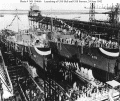 |
167k | USS Bell sliding down the building ways after being christened at the Charleston Navy Yard, South Carolina, 24 June 1942. USS Stevens (DD-479) is alongside, awaiting launching. Naval History & Heritage Command photo NH 104666 | Robert Hurst |
 |
116k | USS Bell (DD-587) and USS Stevens (DD-479) ready for launching at the Charleston Navy Yard, South Carolina, 24 June 1942. National Archives photo 19-N-58158 | Robert Hurst |

| 139k | Just after launching, 24 June 1942. | David Buell |

| 335k | Postcard of the launching of the USS Stevens (DD-479) and USS Bell (DD-587), 24 June 1942. | Tommy Trampp |
 |
207k | Post card of the launching of the USS Bell (DD-587) and USS Stevens (DD-479) at Charleston, 24 June 1942. | Tommy Trampp |
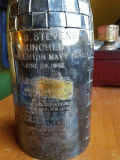
| 139k | USS Stevens christening bottle that LT Lee Fadem placed with the Tin Can Sailors Museum, Somerset, MA. | John Chiquoine |




Scenes from the commissioning ceremony at Charleston, 01 February 1943. | Robert Hall, Dave Schroeder and John Chiquoine |


Stevens on the Cooper River heading to sea for shakedown exercises, 15 March 1943. There were several such day passages before she had the first exercises with a floatplane. Fifty years after, her shipmates' apprehension and frustration in those experiences was still told.
National Archives photos 80-GK-13835 and 80-GK-13834 | John Chiquoine and Rick Davis |
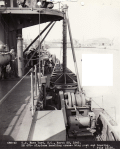
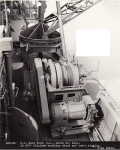

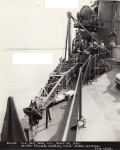
These images show the revised crane as installed on USS Stevens (DD-479) on 20 March 1943, at Charleston Navy Yard. The crane was installed on the portside and could be lowered, then stowed flat on the main deck. The boat winch was used to move the crane and to raise the aircraft.
Official USN Photos in the NARA collection at College Park, MD. | Rick E. Davis |
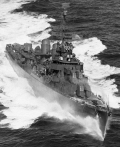
| 252k | USS Stevens (DD-479) underway off the Atlantic coast, July 1943.
National Archives photo 80-G-299546 | Robert Hurst |

| 146k | This July 1943 photo shows a sailor securing a bomb on an OS2U Kingfisher float plane aboard USS Stevens (DD-479). Six Fletcher Class Destroyers, DD-476 through 481, were designated to be Aircraft-Handling destroyers able to launch and recover a Kingfisher float plane from a modified catapult of the type installed on Omaha class cruisers. The catapult replaced the aft torpedo tubes and number 3 5-in gun mount. USS Stevens and USS Halford (DD-480) were completed with a revised crane design to replace the flawed boom crane that USS PRINGLE (DD-477) was completed with. The catapult experiment proved impractical on the small destroyer size vessel and was cancelled in September 1943. Stevens and Halford were refitted at MINY to standard Fletcher class design.
US Navy and Marine Corps Museum/Naval Aviation Museum, Photo No. 2004.166.001.019. This Official USN Photo is also available at NARA, College Park, MD as 80-G-299532 | Mike Green / Rick E. Davis |

| 180k | Recovering her seaplane, 1943. National Archives photo 80-G-299540 | Ed Zajkowski |

| 153k | USS Stevens (DD-479) passing under the Cooper River bridge off the Charleston Navy Yard, South Carolina on 15 March 1943. She carries an aircraft catapult in place of her after torpedo tubes and 5"/38 mount 53. Official U.S. Navy Photograph, from the collections of the Naval History and Heritage Command. Photo #: NH 107410. | Ed Zajkowski/Robert Hurst |



Underway off Charleston, 15 March 1943. | Ed Zajkowski and David Buell |

| 121k | Stevens (DD-479) at Charleston during her inclining experiment, 12 May 1943. Note her aircraft handling crane, the type that was used on the Stevens and Halford (DD-480). The Pringle (DD-477), the third unit to operate a catapult, used a different type of crane. | Rick E Davis |

| 130k | Forward plan view of the USS Halford (DD-480) at Mare Island, 01 December 1943. She was in overhaul at the shipyard from 27 October - 06 December 43. USS Stevens (DD-479) is outboard. Bow of floating drydock ARD-11 is just visible forward of Halford. | Darryl Baker |

| 124k | Aft plan view of the USS Halford (DD-480) at Mare Island, 01 December 1943. USS Stevens (DD-479) is moored outboard. | Darryl Baker |

| 176k | Aft plan view of the USS Stevens (DD-479) at Mare Island, 01 December 1943. She was in overhaul at the shipyard from 11 October - 01 December 1943. USS Halford (DD-480) is inboard of Stevens. | Darryl Baker |

| 111k | Forward plan view of the USS Stevens (DD-479) at Mare Island, 01 December 1943. She was in overhaul at the shipyard from 11 Oct to 1 Dec 1943. USS Halford (DD 480) is inboard of Stevens. Note: Photo is incorrectly labeled as DD 480, but review of shipyard logs indicates that Stevens was outboard of Halford on this date. | Darryl Baker |

| 174k | USS Stevens (DD 479) off Mare Island, 01 December 1943. National Archives photo 19-N-57496, from the collection of the Vallejo Naval and Historical Museum. | Darryl Baker |

| 142k | Mare Island, 01 December 1943. National Archives photo 19-N-57497 | Ed Zajkowski |

| 98k | Stevens moored at Tsingtao, China, 22-27 September 1945. British cruiser HMS Bermuda is moored across the harbor. After the Japanese surrender and after initial sites in Korea were occupied by US forces from Okinawa and the Philippines, USN units were deployed to take control of many the Chinese ports where Jap naval activities remained. USS Stevens and USS New Orleans arrived at Tsingtao on 20 Sept 1945 with the destroyer mooring at wharf#1. Both ships sent prize crews and the cruiser's Marine unit to manage internments. HMS Bermuda and HMS Tuscan joined on 22 Sept. Chinese Nationalist forces arrived 27 Sept and relieved Stevens and New Orleans departed the next day.
Imperial War Museum photo A30933, copyright | John Chiquoine |

| 35k | Stevens officers receive Chinese officers aboard at a Chinese port, November 1945. Courtesy of Bert Bickel. | Dave Schroeder and John Chiquoine |

| 119k | The ship's story that ties in with these happy civilian faces is that while in a Chinese port, Stevens received aboard some repatriated Allied civilians for further transfer. Even this poor photo shows their expression of joy and relief. Courtesy Bert Bickel. | Dave Schroeder and John Chiquoine |

| 181k | A shipmate shutterbug captured this moment with the "Homeward Bound" pennant streaming. Late 1945, courtesy Bert Bickel. | Dave Schroeder and John Chiquoine |

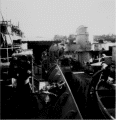
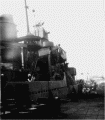
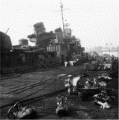
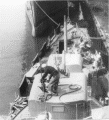
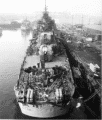
Scenes of the ship at piers and in drydock during her decommissioning period, February and March 1946 at San Pedro, CA. Courtesy Bert Bickel. | Dave Schroeder and John Chiquoine |

